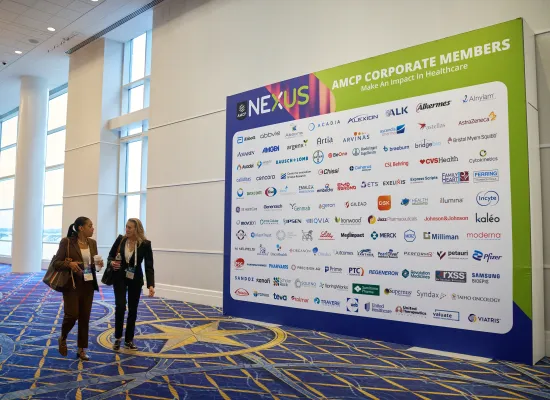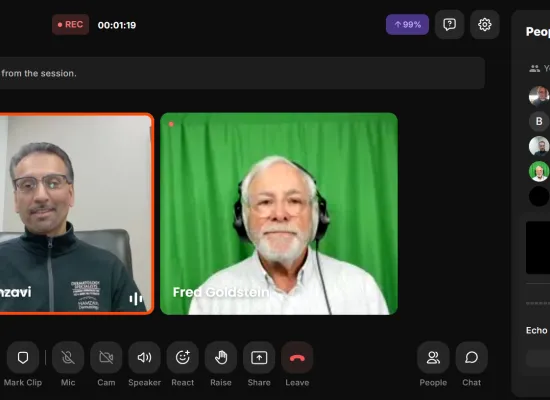
ICYMI: Recapping AMCP's Real-World Evidence Partnership Forum

While real-world evidence (RWE) is increasingly used to support epidemiology and safety studies for regulatory submissions, it hasn’t been widely adopted in managed care. This is primarily due to concerns about data quality, a lack of standardized analysis methods, and a historical preference for randomized controlled trials (RCTs).
On Nov. 12, more than 50 managed care professionals and various health care stakeholders gathered in Old Town Alexandria, Va. to examine these barriers to adoption for RWE in managed care. The multi-day meeting, our latest Partnership Forum event hosted by the AMCP Research Institute, consisted of a series of workshops that challenged participants to examine opportunities and challenges posed by RWE use and identify ways to address these barriers to adoption through refining and applying a set of RWE standards geared toward payer decision-makers that we have developed over the past year.
We figured the best way to address this immensely useful collection of data—which has vast implications for how we go about our work—was to bring everyone together to have frank and nuanced discussions about RWE. And bring people together we did! Experts from pharmaceutical manufacturers, public and private health plans, data scientists, PBMs, and integrated delivery networks were in attendance, allowing us to have a variety of perspectives present. AMCP’s CEO Susan Cantrell said it best:
“Although communication can happen organically, it often helps to be intentional. When it comes to developing agreed-upon standards, when it comes to aligning on definitions, honest dialogue goes a long way in making a constructive difference.”
What we heard
I was so honored to be a moderator of the partnership forum, alongside Elizabeth Powers, Vice President and General Manager of Real World Strategy and Innovation at IQVIA. We were able to help facilitate these conversations across workshops and stakeholders. On day one, we were laser-focused on refining our definitions of RWE and how it's used throughout a drug product’s life cycle—and then on day two, we built on our discussions the day before and walked through some simulations of how to apply our RWE standards—a framework and set of criteria—in real life.
Day One
- Our first session was an open forum to gain consensus on a finalized framework for using RWE. Attendees were asked to dive deep into how they thought RWE would provide value to a variety of stakeholders and audiences. We also talked through frameworks for specific disease categories, noting where differences lie. For example, different study types and data sources were viewed differently when considering a rare disease versus a common disease.
- Now that we had aligned on the framework elements, we wanted to dig into our draft criteria for evaluating RWE studies—finding what’s relevant, what can be deprioritized, and identifying gaps. During our exercise, we really wanted to facilitate a conversation about which criteria participants felt were most important and potentially useful in their study design or formulary decision-making processes, and what was missing from the list. This was followed by a lively discussion around why certain criteria were more or less relevant for different organizations. We closed out the day with agreement on the revised framework and criteria.
Day Two
- This is when the real fun started. We tested the framework and criteria refined the day before with real case studies from the published literature to identify gaps or areas for further refinement. It was an eye-opening session—demonstrating that what looks good on paper may need further refinement in practice. The group found that not all criteria were relevant for every study type or scenario (e.g., a product not yet approved versus one with three years of utilization), and streamlining the criteria into subsets that fit different categories.
- From there, we took on the role of either a sponsor or payer to get a better sense of how useful and effective the standards were in guiding best practices for presenting or reacting to RWE. Our “sponsors” developed a presentation using the framework and the criteria, and the information shared was then evaluated by our “payers.” We wrapped up the workshops by discussing and finalizing our RWE framework and criteria—creating our own standards for RWE usage in a managed care setting. It was so fascinating to see how standards changed throughout the course of the forum as participants heard each other’s perspectives.
Turning insights into action
Based on these insightful conversations and alignment, the AMCP Research Institute will revise the RWE framework and criteria checklist, in addition to preparing a manuscript detailing the standards we discussed. Refining these documents will give us a better reference point moving forward to lower barriers to access for RWE.
This partnership forum is part of a larger initiative to ultimately integrate RWE into formulary evaluation. Stay tuned for more on how we’re streamlining the RWE standards process. We’re working to expand awareness and implementation of RWE standards across the health care system in 2025 and beyond. To learn more about AMCP’s RWE initiative, visit this webpage.
Looking for a peek behind the curtain to see what the energy was like on the ground? Check out this quick video highlight reel (and see a familiar face towards the end of the video).
Lastly, a wholehearted thank you to our generous sponsors; this event would not have been possible without their support. Learn more about sponsoring a future Partnership Forum.
AMCP Partnership Forum events bring together key decision-makers in managed care, integrated care networks, the pharmaceutical industry, and other vital sectors to collaborate on strategies to improve patient outcomes. Explore this and other membership benefits by visiting www.amcp.org/member.

Cate Lockhart, PharmD, PhD
Chief Science Officer, AMCP & Executive Director, BBCIC
Published on Dec. 11, 2024
Featured News & Resources
See Full CalendarAMCP Southwest Day of Education
Award Applications Open
Upcoming Events
AMCP offers a wide variety of educational opportunities, from events and webinars to online training.







